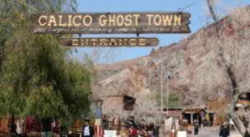
California Symbols
California State Silver Rush Ghost Town
Calico

Location:
Calico is located northeast of Yosemite about 13 miles off of Highway 395 on Calico Road and 7 miles south of Bridgeport.Adopted on July 19, 2005
Calico was designated as the official California State Silver Rush ghost town in 2002. In 1962 it was named a National Historic Site and a California State Historic Park. It once housed a population of 10,000, but now it is preserved in a state of arrested decay. What was left of the town's buildings and contents remains as they did after the last resident departed.
;California State Silver Rush Ghost Town: Calico
Adoption
Backed by the County of San Bernadino, State Senator Roy Ashburn introduced Senate Bill No. 906 on February 22, 2005. The Senate Committee on Governmental Organization released the following background as part of their analysis.
The author is carrying this measure on behalf of San Bernardino County. The sponsor states the San Bernardino is the home to Calico Ghost Town, a popular tourist destination with a history based on the silver rush.
Calico is located off interstate 15, just a little north of Barstow. Born in 1881, Calico boasted boomtown status, producing $86 million in silver, $45 million in borax, and a town population of 1,200 with 22 saloons, China town mercantile stores, and a red light district. Over 500 mines including the legendary Silver King, Oriental and Bismarck were the engines that drove Calico's great wealth between the years of 1881 and 1907.
The sponsor further states that like most boomtowns of the time period, when the price of silver dropped from $1.31 an ounce to $.63 an ounce, Calico became a ghost town of its former self. Today, Calico is one of the few remaining original and historical mining towns of the western United States, and the home of Tumbleweed Harris and the legendary 1885 Mail Dog "Dorsey."
Today, operating as a San Bernardino County Regional Park, Calico is alive and well. This regional park sits on 480 acres adjacent to federal lands administered by the Bureau of Land Management. There are numerous concessions in Calico offering a wide selection of opportunities from visiting an old mine to shopping on Main Street for crafts and collectibles. The town is host to a variety of special events throughout the year attracting many return visitors.
Approximately 500,000 people visit Calico annually.
With virtually no opposition, Senate Bill No. 906, making Calico the "official state silver rush ghost town" of California passed through
the Senate and Assembly by July 5, 2005.
On July 19, 2005, Governor Arnold Schwarzenegger signed the legislation adopting Calico as the official state silver rush ghost town of California.ame
remains unknown today. It may have been named for gold miner W. S. Body also known as William S. or Waterman S. Body or his name may have been Wakeman
S. Bodey. The name Calico was given to the camp that was near the site where he discovered gold in 1859. It was not until 1877 when gold was discovered
in quantity and the population increased that Calico grew in size from 3,000 up to 10,000 by 1880. The mining boom ended in the early 1880's and by
1888 about $18,000,000 worth of gold had been mined, but only 3 mines were left from the 40 to 50 that had existed during the boom years.
California Law
The law designating Calico as the official California state silver rush ghost town is found in the California Government Code, specifically Title 1, Division 2, Chapter 2, Section 429.8.
CALIFORNIA GOVERNMENT CODE
TITLE 1. GENERAL
DIVISION 2. STATE SEAL, FLAG, AND EMBLEMS
CHAPTER 2. STATE FLAG AND EMBLEMS
SECTION 420-429.8
429.8. Calico is the official state silver rush ghost town.







